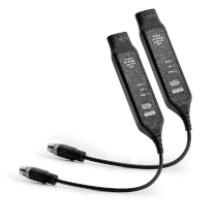Getting Started
The Kvaser Air Bridge is a wireless communication device that allows for two separate CAN networks to seamlessly connect via our proprietary wireless protocol. Our protocol is designed to offer robust, low latency communication between the devices. While the Air Bridge, just as any single radio solution, cannot support arbitration due to radio communication lacking the ability to transmit and receive at exactly the same time, our protocol automatically converts bit rates as messages travel across the wireless bridge.

Kvaser Air Bridge Light HS: A configuration-free wireless CAN bridge that achieves predictable latency, without sacrificing stability or range.
Kvaser Air Bridge M12: A small, yet advanced, wireless CAN bridge that retains a certain flexibility for the user by means of configuration; choose between ’one to one’, or ’one to any’.

With the Kvaser Air Bridge there is no longer a need to run messy cables between systems or worry about converting different bit rates between networks. Depending on the device chosen for your system, you may not need to configure the Air Bridge at all as these devices also support automatic bit rate detection. With the right CAN network design, a Kvaser Air Bridge Light is plug-and-play.
For more advanced applications, the Kvaser Air Bridge one-to-any is even capable of receiving and responding to special instructions sent across the CAN bus via the Kvaser Air Bridge Management Interface. This feature allows for user applications to monitor and control an Air Bridge over the CAN bus.
But we’re getting ahead of ourselves. First, let’s look at how to configure the Kvaser Air Bridge.